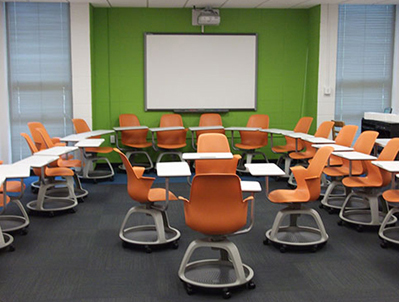U Tennessee's New Classrooms Focus on Student-Centric Learning

Source: University of Tennessee |
The University of Tennessee at Knoxville (UT) has completed a $3.5 million redesign of its Humanities and Social Sciences building. The renovation supports the university's aim to replace traditional classrooms with new learning spaces that foster collaboration and student-centric learning.
"We are hoping to move from classrooms with static fronts to dynamic classrooms that facilitate student interaction and expression where faculty members are experts as well as facilitators/mentors," said Bill Dunne, associate dean of the College of Engineering and chair of the Classroom Upgrade Subcommittee, in a statement released Tuesday by the institution. The Classroom Upgrade Subcommittee supervised the makeover project.
All 36 classrooms in UT's updated facility--first built in the mid-1960s--have been outfitted with new furniture, interactive white boards, HD video capability, WiFi, and mobile "Node" chairs. The upgrade, says Stan Guffey, member of the subcommittee and Faculty Scholar with the Tennessee Teaching and Learning Center, enables the institution to accommodate different learning styles, better integrate technology into instruction, and emphasize the value of on-campus learning.
"What we are involved in is an institutional culture change," explains Guffey. "The 'brick and mortar' university is going to persist because we are offering something better. We have the added value of the collaborative learning, the social elements, which is how we operate in a professional environment."
The layout of the new classrooms is designed to support student-centric learning. Instead of sitting in rows of desks facing the lecturer at front of the room, students now sit in mobile desks arranged in clusters or in a large circle about the room.
"Lectures have served as the primary instructional approach for centuries, if not millennia," notes Dunne. "Yet, they're dominantly a one-way information flow that creates little expectations or responsibilities for students during that class time. The new classrooms support learning strategies that make the students the center of the learning expectations during class time, while challenging them to learn, collaborate, and adapt in real-time."
Staff from the Tennessee Teaching and Learning Center trained faculty members on how to use the new classroom technologies and adjust their instructional approach during a series of dialogues held at the new facility.
Initial response to the updated facility has been positive, according to feedback from students and faculty on a survey conducted last fall. "I have noticed that in the newer classrooms with the all the technology the students are much more engaged with the course material," says Jennifer Fowler, mathematics senior lecturer. "They are not passive learners like they are in traditional classrooms where you are writing on the board and they are sitting and copying. You can get them to relax a little bit more, and I think they feel more comfortable and they can help each other." UT plans to conduct a new survey this spring to assess student enrichment.
A number of university departments participated in the renovation, including the Classroom Upgrade Committee, Facilities Services, the College of Architecture and Design, the Tennessee Teaching and Learning Center, University Libraries, and the Office of Information Technology.
The University Tennessee at Knoxville is the flagship institution of the University of Tennessee system. Nearly 28,000 students are enrolled in the institution's nine undergraduate colleges and 11 graduate schools. Additional information about UT can be found at the university's Web site.
About the Author
Kanoe Namahoe is online editor for 1105 Media's Education Group. She can be reached at [email protected].